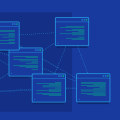Git Version Control System is an incredibly powerful and versatile tool for managing and tracking changes to source code using branches and merging in Git. It is a distributed version control system, which means that multiple copies of the source code can exist on different computers and be merged together when needed. With Git, developers can easily track and review changes made to their code, making it easier to collaborate and stay organized. Whether you are a beginner or a pro, this article will provide an introduction to the basics of Git Version Control System and help you understand how to use it effectively. Git Version Control System is an incredibly powerful and versatile tool for managing and tracking changes to source code using branches and merging in Git. It is a distributed version control system, which means that multiple copies of the source code can exist on different computers and be merged together when needed. With Git, developers can easily track and review changes made to their code, making it easier to collaborate and stay organized. Whether you are a beginner or a pro, this article will provide an introduction to the basics of Git Version Control System and help you understand how to use it effectively.
Tagging & Stashing
Tagging is a way of creating snapshots of your codebase at a certain point in time. It allows you to easily go back to that version if needed.You can also create tags to mark specific releases or versions. Stashing is a way of temporarily storing changes that you have made to your codebase. It allows you to switch branches, make changes, and then come back to the original branch without having to commit the changes. This is useful for making quick changes or testing out different ideas. Both tagging and stashing are useful ways of managing your codebase and making sure that you always have access to the version you need.
Using these techniques can help make your development process more efficient and organized.
Collaboration Features
Git's collaboration features are among its most powerful tools. Pull requests and code reviews are two of the most important of these features. In this section, we'll explain what pull requests and code reviews are, how they work, and how they can be used to streamline the development process. Pull requests are a feature of Git that allows developers to request changes from other developers. They are used to suggest changes to code, as well as to discuss the changes before they are merged into the main project.When someone makes a pull request, they submit their changes for review by another developer or team of developers. The reviewers can then discuss the changes, approve them, or reject them. Code reviews are an important part of the development process. They allow developers to review and comment on code changes before they are accepted into the project. This ensures that the quality of code is maintained and any mistakes are caught before they become a problem.
Code reviews also provide an opportunity for collaboration between developers, as they can discuss different approaches and suggest improvements. By using pull requests and code reviews, developers can ensure that their projects are up to date and properly managed. The collaboration features of Git make it easy for developers to collaborate on projects and keep their code up to date.
Creating a Repository
A repository is an essential part of using Git version control system. It's a place where all your project files, as well as the historical changes made to them, are stored. In other words, it's a single place to store all the versions of your project and its source code.When you create a repository, you will be able to commit changes, track their progress, and collaborate with other developers. Creating a repository is simple and straightforward. You can either create a repository on your local machine or use a remote service like GitHub or Bitbucket. To create a repository on your local machine, you will need to open the terminal and navigate to the directory where you want to store your project files. Then run the following command:git initThis command will create an empty repository in the current directory. If you want to use a remote service, you will need to create an account on the service and follow the instructions for setting up a repository.
Once you have created your repository, you can start adding files, making changes, and tracking their progress. It's important to remember that repositories are versioned. This means that each time you make changes to your project files, they will be stored in the repository. This allows you to go back in time and review previous versions of your project if needed.
Committing Changes
When using Git, committing changes is the process of recording changes to a file or set of files in the repository. When you commit changes, you are creating a snapshot of the current state of your project which can be used to roll back to a previous version at any time.Committing changes is essential to the version control process and allows developers to track and manage the history of their project. The process of committing changes is relatively simple. First, you need to make sure that all the changes you want to commit have been staged - this is done by using the git add command. Once the changes have been staged, you can commit them by using the git commit command. This will create a snapshot of the current state of your project, and store it in the repository. It's important to note that you should always include a commit message when committing changes.
This message should provide a brief description of what has been changed and why. This helps other developers understand what has been done and why it was necessary. Additionally, a good commit message can help you remember what you were doing when you come back to the project in the future. When working with other developers on a project, it's important to remember to push your commits regularly. This allows other developers to access your changes, and helps keep everyone on the same page.
To push your commits, you can use the git push command.
Branching
Branching is a key feature of version control systems like Git that allows developers to create separate versions of their code. It allows developers to experiment with new features and test them in isolation without affecting the main branch of code. This helps developers to be creative with their coding without compromising the stability of the original code. In Git, branches are created from the main branch and are used to store changes.Branches are usually named according to the type of work being done on them, such as a feature branch or a bug-fix branch. All the changes made in a branch are tracked separately from the main branch, so they can be merged back into it when they are ready. When a branch is merged back into the main branch, all its changes are applied, including any conflicts that have arisen. This allows developers to easily keep track of different versions of their code and merge changes from multiple branches. It also allows for faster development cycles since code can be tested and merged quickly. Using branching effectively can help streamline development processes and increase collaboration between developers.
By creating separate branches for different tasks, developers can work in parallel without affecting each other's progress. This saves time and helps ensure that changes are made correctly. Git is an invaluable resource for developers looking to streamline their development process. With version control, branching, tagging, stashing, and collaboration features, Git provides a comprehensive suite of tools that make it easy to manage projects and collaborate with other developers. By understanding the basics of how Git works and utilizing its features to their fullest potential, developers can make the most of this powerful version control system.











